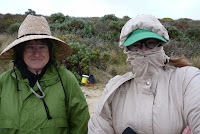.jpg) |
| A sample page of the Field Catalogue |
So, each afternoon I unpacked all the fossils from the black backpack and from any other backpacks and buckets we pressed into service. Once we even had a handful of fossils carried up in a seed tray.
I would sort through them, setting aside all labelled "Microscope Check". You might not have known I had a microscope in my cabin. So I would check these, most of the time getting a second opinion from Lesley or Dave. Many of these were not really bone (some coal, some seed pods, some beetlebums, some a mineral that Lesley called muscovite), but those that were got added back to the fossil pile.
Then I updated the Field Catalogue, writing a reference number on each fossil and recording it.
And then I packed the fossils into boxes to take back to the museum, leaving aside any that Dave thought that Tom might like to see (given how crumbly the rock gets once it dries I left the unwrapping of those important specimens to Dave since he could then look after them straight away).
This catalogue is important for a couple of reasons. Mostly it allows Dave to make sure that all fossils make it to the museum to be evaluated, and to record the eventual disposition of each specimen. Perhaps 20% (or slightly more) of the fossils we found will turn out to be good enough (once seen in laboratory conditions and sometimes with a little matrix removed) to become part of the museum's collection.
Also one of the conditions of our permit from Parks is that we list all of the fossils so that they know that they are going to the museum and not to the pockets of private collectors.
I guess, too, that this also explains why I usually had all the fossil stats at my fingertips.
+(800x533).jpg)
+(800x533).jpg)

.jpg)
.jpg)
.jpg)
.jpg)
.jpg)
.jpg)
.jpg)
.jpg)
.jpg)
.jpg)
.jpg)
.jpg)
.jpg)
.jpg)
.jpg)
.jpg)
.jpg)
.jpg)
.jpg)
.jpg)
.jpg)









.jpg)
.jpg)
.jpg)
.jpg)
.jpg)
.jpg)
.jpg)
.jpg)
.jpg)
.jpg)
.jpg)
.jpg)
.jpg)
.jpg)
.jpg)
.jpg)
.jpg)
.jpg)
.jpg)
.jpg)
.jpg)
.jpg)
.jpg)
.jpg)
.jpg)
.jpg)